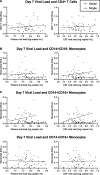Effect of Single Housing on Innate Immune Activation in Immunodeficiency Virus-Infected Pigtail Macaques ( Macaca nemestrina ) as a Model of Psychosocial Stress in Acute HIV Infection
- PMID: 36162063
- PMCID: PMC9553260
- DOI: 10.1097/PSY.0000000000001132
Effect of Single Housing on Innate Immune Activation in Immunodeficiency Virus-Infected Pigtail Macaques ( Macaca nemestrina ) as a Model of Psychosocial Stress in Acute HIV Infection
Abstract
Objective: Simian immunodeficiency virus (SIV) infection of macaques recapitulates many aspects of HIV pathogenesis and is similarly affected by both genetic and environmental factors. Psychosocial stress is associated with immune system dysregulation and worse clinical outcomes in people with HIV. This study assessed the impact of single housing, as a model of psychosocial stress, on innate immune responses of pigtailed macaques ( Macaca nemestrina ) during acute SIV infection.
Methods: A retrospective analysis of acute SIV infection of 2- to si6-year-old male pigtailed macaques was performed to compare the innate immune responses of socially ( n = 41) and singly ( n = 35) housed animals. Measures included absolute monocyte count and subsets, and in a subset ( n ≤ 18) platelet counts and activation data.
Results: SIV infection resulted in the expected innate immune parameter changes with a modulating effect from housing condition. Monocyte number increased after infection for both groups, driven by classical monocytes (CD14 + CD16 - ), with a greater increase in socially housed animals (227%, p < .001, by day 14 compared with preinoculation time points). Platelet numbers recovered more quickly in the socially housed animals. Platelet activation (P-selectin) increased by 65% ( p = .004) and major histocompatibility complex class I surface expression by 40% ( p = .009) from preinoculation only in socially housed animals, whereas no change in these measures occurred in singly housed animals.
Conclusions: Chronic psychosocial stress produced by single housing may play an immunomodulatory role in the innate immune response to acute retroviral infection. Dysregulated innate immunity could be one of the pathways by which psychosocial stress contributes to immune suppression and increased disease severity in people with HIV.
Copyright © 2022 The Author(s). Published by Wolters Kluwer Health, Inc. on behalf of the American Psychosomatic Society.
Figures



References
-
- Global HIV & AIDS Statistics—2020 Fact Sheet | UNAIDS. Available froat: https://www.unaids.org/en/resources/fact-sheet. Accessed March 23, 2021.
-
- Global Statistics | HIV.gov. Available at: https://www.hiv.gov/hiv-basics/overview/data-and-trends/global-statistics. Accessed March 23, 2021.
-
- Anteraper SA Gopinath K Hoch MJ Waldrop-Valverde D Franklin D Letendre SL, et al. . A comprehensive data-driven analysis framework for detecting impairments in brain function networks with resting state fMRI in HIV-infected individuals on cART. J Neurovirol 2021;27:239–48. - PubMed
-
- Siliciano JD, Siliciano RF. Recent developments in the search for a cure for HIV-1 infection: targeting the latent reservoir for HIV-1. J Allergy Clin Immunol 2014;134:12–9. - PubMed
Publication types
MeSH terms
Substances
Grants and funding
- U42 OD013117/OD/NIH HHS/United States
- P30 MH075673/MH/NIMH NIH HHS/United States
- P30 AI094189/AI/NIAID NIH HHS/United States
- R01 NS089482/NS/NINDS NIH HHS/United States
- P01 MH070306/MH/NIMH NIH HHS/United States
- R01 NS097221/NS/NINDS NIH HHS/United States
- T32 AI102623/AI/NIAID NIH HHS/United States
- T32 OD011089/OD/NIH HHS/United States
- P40 OD013117/OD/NIH HHS/United States
- P01 AI131306/AI/NIAID NIH HHS/United States
- K01 OD018244/OD/NIH HHS/United States
- R01 NS055651/NS/NINDS NIH HHS/United States
- P40 RR019995/RR/NCRR NIH HHS/United States
LinkOut - more resources
Full Text Sources
Medical
Research Materials

